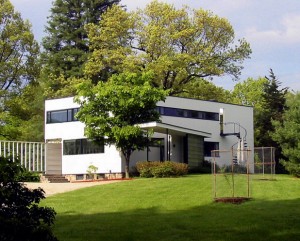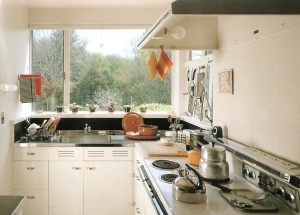Culture Vulture at the Gropius House

The facade of the Gropius House in Lincoln, MA
Visiting the Frelinghuysen Morris House in Lenox got me thinking about modernist architecture in the eastern part of Massachusetts where Walter Gropius landed as part of the great exodus of “degenerate” artists, scientists, writers and other intellectuals who fled to America from Nazi Germany in the years before the second world war.
by Helen Epstein
Go here for information about a live-chat, scheduled for August 23rd, with Helen Epstein on “The Art of Narrative Writing.”
These thousands of refugees, or “emigres” as some preferred to be called, formed sizable communities in the cities of New York, Chicago and Los Angeles (where many of the writers, screenwriters, composers and musicians resettled), and Chicago but they also lived quietly in such small towns as Lincoln, Massachusetts, where in 1937 Gropius built a home in an apple orchard belonging to a local philanthropist.
Gropius was canny in his dealings with the Nazis: citing the extraordinary nature of Harvard’s invitation to a German rather than French architect to teach at its School of Design, he asked an intermediary to intercede with Goebbels on his behalf, and was able to bring all his possessions — including books, correspondence and his Marcel Breuer collection of Bauhaus furniture — to Lincoln where you can see it and experience the total Bauhaus aesthetic year-round.
Gropius’ second wife Ise (his first was Alma, later-to-become-Mahler and Werfel) compiled a detailed and blow-by-blow account of how the house was acquired and built: the land was donated by Mrs. James Storrow (widow of the man who established the Charles River Basin and Dam at the turn of the twentieth century and for whom Boston’s Storrow Drive is named). She allotted four acres to Gropius because he had a wife and child; Marcel Breuer got only two since he was a bachelor.
As many architecture students and clients of architects have learned –sometimes to their dismay — you can’t really “get” architecture until you’ve walked through it, sat in it, experienced a space in real time under your feet and around you rather than looking at a picture. That experience is instructive for visitors to the compact 2400-square foot, two-storey, four bed-room, four bathroom house where the architect, his wife, his daughter, and a housekeeper lived. It makes the Bauhaus phrase “maximum result with minimum means” real.
Every aspect of the house and surroundings was designed for maximum efficiency and although modernism is now history, I felt very much as though I was walking through a futuristic experiment. Although my husband and I are tall people who prefer high ceilings and large rooms, we were surprised by the roomy feel of the 8 ft. 4 inch ceilings that Gropius designed on the first floor and even lower ones on the second.
Ise Gropius’ booklet describes the scouting process that preceded the design: road trips throughout New England to examine how Americans had adapted English Georgian style to the extreme climate demands of torrid summers and frigid winters. He was especially struck by the use of wood instead of brick or stone, by the placement of doors and windows for ventilation, by the use of open hearths instead of tile stoves. He saw fireplaces as a good back-up to other the three separately regulated heating systems as well as a source of great psychological comfort.
Through his Harvard colleagues, Gropius located a local builder who is quoted as finding his employer’s ideas “most unusual,” especially the idea of a flat roof.
“Gropius wanted to get rid of the constant repair problems of peaked roofs with their shingle covering and the necessity of providing drainpipes in a place where rainfalls could be torrential and snowfalls were apt to ice up any pipes,” according to Mrs. Gropius. “But he took the precaution to slant the roof slightly towards the center, where a drain, running down the middle of the house where it cannot freeze, took care of any run-off of rain or melting snow. In the forty years of its existence no trouble has ever arisen from this arrangement.”

The kitchen in the Gropius House included a garbage disposal.
Sitting in the living room of the Gropius house — there is one throw-covered recliner in which one is allowed to sit, take in the surrounding Breuer furniture and gaze out the wall of living room window — is a thrilling experience both of aesthetics and the history of art. Like Freud, Gropius contributed so many concepts to the way we now live that I repeatedly found myself thinking “Oh that’s where this came from…” as I followed my guide.
Gropius House is open year-round. It’s down the road a minute from the De Cordova Museum and not far from Walden Pond.
Tagged: A Serious Man, Berkshires, Culture Vulture, gropius House, Ise Gropius

[…] Excerpt from: Culture Vulture at the Gropius House : The Arts Fuse Blog […]
Most designers focus on the living room, dinning room, kitchen and bathroom design. But more care today needs to be taken with the home office, since more and more work is being done at home. I have a blog where I talk about these issues bamboo home decor, where, for example, I consider the demand for new and improved desk lighting because of work demands.